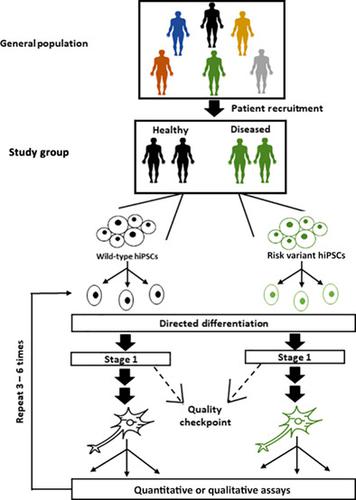当前位置:
X-MOL 学术
›
STEM CELLS
›
论文详情
Our official English website, www.x-mol.net, welcomes your feedback! (Note: you will need to create a separate account there.)
Replicates in Stem Cell Models - How Complicated!
STEM CELLS ( IF 5.2 ) Pub Date : 2020-06-10 , DOI: 10.1002/stem.3237 Jun-Wei Chan 1, 2 , Adrian K K Teo 1, 3
STEM CELLS ( IF 5.2 ) Pub Date : 2020-06-10 , DOI: 10.1002/stem.3237 Jun-Wei Chan 1, 2 , Adrian K K Teo 1, 3
Affiliation

|
Replicates are indispensable for reproducibility, reliability and accuracy of experimental results. Replication lends statistical power and boosts the credibility of conclusions drawn from an experiment. Traditionally, experiments done on terminally-differentiated cells are performed in minimally three independent and separate occasions to account for "biological triplicate" needed to perform statistical analyses. With the advent of stem cell biology and routine differentiation of human embryonic stem cells (hESCs) or human induced pluripotent stem cells (hiPSCs) into a multitude of desired cell types, there is a routine requirement to incorporate replicates in each individual experimental set-up, coupled with several experimental repeats to generate robust and reproducible data. Unfortunately, to date, there are no precise guidelines that explicate requirements for valid "technical" and/or "biological" replicates in stem cell-based experimental studies. In the context of human pluripotent stem cell (hPSC) differentiation studies, experimental replicate designs are made complicated due to line-to-line variability and heterogeneity in every individual well of stem cell differentiation, leading to significant challenges in identifying true biological phenotypes; especially in complex diseases with subtle differences in phenotypes. In this Commentary article, we discuss current practices in the field with regards to experimental replication and provide our opinions on how to tackle the related issues. © AlphaMed Press 2020 SIGNIFICANCE STATEMENT: The routine differentiation of human pluripotent stem cells into a multitude of desired cell types has increased the complexity of requirement for technical or biological replicates in stem cell-based experimental studies. Traditional definitions of technical or biological replicates may no longer apply clearly to stem cell differentiation models due to line-to-line variability and heterogeneity in every individual well of stem cell differentiation. In this Commentary article, we discuss current practices in the field with regards to experimental replication and provide our opinions on how to tackle the related issues.
中文翻译:

干细胞模型中的复制——多么复杂!
重复对于实验结果的重现性、可靠性和准确性是必不可少的。复制提供了统计能力并提高了从实验中得出的结论的可信度。传统上,对终末分化细胞进行的实验至少在三个独立和独立的场合进行,以解释执行统计分析所需的“生物三次重复”。随着干细胞生物学的出现和人类胚胎干细胞 (hESCs) 或人类诱导多能干细胞 (hiPSCs) 向多种所需细胞类型的常规分化,常规要求在每个单独的实验设置中加入重复,再加上几次实验重复,以生成可靠且可重复的数据。不幸的是,迄今为止,在基于干细胞的实验研究中,没有明确的指南来解释对有效“技术”和/或“生物学”复制的要求。在人类多能干细胞 (hPSC) 分化研究的背景下,由于干细胞分化的每个单独孔中的线间变异性和异质性,实验重复设计变得复杂,从而导致在识别真正的生物表型方面面临重大挑战;尤其是在表型存在细微差异的复杂疾病中。在这篇评论文章中,我们讨论了该领域在实验复制方面的当前做法,并就如何解决相关问题提供了我们的意见。© AlphaMed Press 2020 年重要声明:人类多能干细胞向多种所需细胞类型的常规分化增加了基于干细胞的实验研究中技术或生物学复制要求的复杂性。由于干细胞分化的每个单独孔中的线间变异性和异质性,技术或生物学重复的传统定义可能不再清楚地适用于干细胞分化模型。在这篇评论文章中,我们讨论了该领域在实验复制方面的当前做法,并就如何解决相关问题提供了我们的意见。由于干细胞分化的每个单独孔中的线间变异性和异质性,技术或生物学重复的传统定义可能不再清楚地适用于干细胞分化模型。在这篇评论文章中,我们讨论了该领域在实验复制方面的当前做法,并就如何解决相关问题提供了我们的意见。由于干细胞分化的每个单独孔中的线间变异性和异质性,技术或生物学重复的传统定义可能不再清楚地适用于干细胞分化模型。在这篇评论文章中,我们讨论了该领域在实验复制方面的当前做法,并就如何解决相关问题提供了我们的意见。
更新日期:2020-06-10
中文翻译:

干细胞模型中的复制——多么复杂!
重复对于实验结果的重现性、可靠性和准确性是必不可少的。复制提供了统计能力并提高了从实验中得出的结论的可信度。传统上,对终末分化细胞进行的实验至少在三个独立和独立的场合进行,以解释执行统计分析所需的“生物三次重复”。随着干细胞生物学的出现和人类胚胎干细胞 (hESCs) 或人类诱导多能干细胞 (hiPSCs) 向多种所需细胞类型的常规分化,常规要求在每个单独的实验设置中加入重复,再加上几次实验重复,以生成可靠且可重复的数据。不幸的是,迄今为止,在基于干细胞的实验研究中,没有明确的指南来解释对有效“技术”和/或“生物学”复制的要求。在人类多能干细胞 (hPSC) 分化研究的背景下,由于干细胞分化的每个单独孔中的线间变异性和异质性,实验重复设计变得复杂,从而导致在识别真正的生物表型方面面临重大挑战;尤其是在表型存在细微差异的复杂疾病中。在这篇评论文章中,我们讨论了该领域在实验复制方面的当前做法,并就如何解决相关问题提供了我们的意见。© AlphaMed Press 2020 年重要声明:人类多能干细胞向多种所需细胞类型的常规分化增加了基于干细胞的实验研究中技术或生物学复制要求的复杂性。由于干细胞分化的每个单独孔中的线间变异性和异质性,技术或生物学重复的传统定义可能不再清楚地适用于干细胞分化模型。在这篇评论文章中,我们讨论了该领域在实验复制方面的当前做法,并就如何解决相关问题提供了我们的意见。由于干细胞分化的每个单独孔中的线间变异性和异质性,技术或生物学重复的传统定义可能不再清楚地适用于干细胞分化模型。在这篇评论文章中,我们讨论了该领域在实验复制方面的当前做法,并就如何解决相关问题提供了我们的意见。由于干细胞分化的每个单独孔中的线间变异性和异质性,技术或生物学重复的传统定义可能不再清楚地适用于干细胞分化模型。在这篇评论文章中,我们讨论了该领域在实验复制方面的当前做法,并就如何解决相关问题提供了我们的意见。


























 京公网安备 11010802027423号
京公网安备 11010802027423号